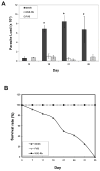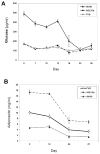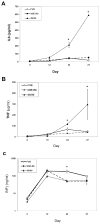Crucial role of the central leptin receptor in murine Trypanosoma cruzi (Brazil strain) infection - PubMed (original) (raw)
. 2010 Oct 1;202(7):1104-13.
doi: 10.1086/656189.
Dazhi Zhao, Fabiana S Machado, Louis M Weiss, Gary J Schwartz, Mahalia S Desruisseaux, Yang Zhao, Stephen M Factor, Huan Huang, Chris Albanese, Mauro M Teixeira, Philipp E Scherer, Streamson C Chua Jr, Herbert B Tanowitz
Affiliations
- PMID: 20726767
- PMCID: PMC2932826
- DOI: 10.1086/656189
Crucial role of the central leptin receptor in murine Trypanosoma cruzi (Brazil strain) infection
Fnu Nagajyothi et al. J Infect Dis. 2010.
Abstract
Mice carrying a defective leptin receptor gene (db/db mice) are metabolically challenged and upon infection with Trypanosoma cruzi (Brazil strain) suffer high mortality. In genetically modified db/db mice, (NSE-Rb db/db mice), central leptin signaling is reconstituted only in the brain, which is sufficient to correct the metabolic defects. NSE-Rb db/db mice were infected with T. cruzi to determine the impact of the lack of leptin signaling on infection in the absence of metabolic dysregulation. Parasitemia levels, mortality rates, and tissue parasitism were statistically significantly increased in infected db/db mice compared with those in infected NSE-Rb db/db and FVB wild-type mice. There was a reduction in fat mass and blood glucose level in infected db/db mice. Plasma levels of several cytokines and chemokines were statistically significantly increased in infected db/db mice compared with those in infected FVB and NSE-Rb db/db mice. These findings suggest that leptin resistance in individuals with obesity and diabetes mellitus may have adverse consequences in T. cruzi infection.
Conflict of interest statement
Authors have no commercial or financial interest or conflict of interest
Figures
Figure 1
A. Parasitemia in mice infected with T. cruzi (Brazil strain) (n=5 for each group). 1B: Mortality in mice infected with T. cruzi (Brazil strain). Beginning with 18 days post infection there was a significant (* p<0.05) increase in peripheral parasitemia in infected db/db mice and a 100% mortality compared with NSE-RB db/db and FVB mice (top line).
Figure 2
Representative myocardial histopathology in mice infected with T. cruzi (Brazil strain). Top panels are all low power (10X) and bottom panels are all high power (20x). db/db (LEPR-B null mice), NSE-Rb db/db and FVB mice. Note the increase parasite load and inflammation in the infected db/db mice. Arrows point to pseudocysts which contain T. cruzi amastigotes.
Figure 3
A: Blood glucose determinations in mice infected with T. cruzi (Brazil strain) (n=5 for each group) over 27 days post-infection. There was a significant reduction (p<0.05) in blood glucose concentration in infected db/db mice beginning at day 15 post infection. In the FVB and NSE-RB db/db mice the reduction in blood glucose was significant at day 22 post-infection compared to day zero**. B:** Adiponectin levels in mice infected with T. cruzi (Brazil strain) (n=5 for each group). There was a significant reduction (p<0.05) in adiponectin levels in all 3 groups compared to day zero. Note that in the db/db mice, there was a significant reduction in adiponectin prior to infection.
Figure 4
Plasma cytokine levels in mice infected with T. cruzi (Brazil strain) (n=5 for each group) over 27 days post-infection. There was a significant (*p<0.05) increase in IL-6 and TNF-α in infected db/db mice compared with FVB and NSE-RB db/db mice. The levels of IFN-γ were increased in all three groups but were significantly increased (*p<0.05) in db/db mice compared with FVB and transgenic only at day 24 post infection.
Figure 5
Plasma chemokine levels in mice infected with T. cruzi (Brazil strain) (n=5 for each group) over 27 days post-infection. Levels of CCL-2, CCL-3 and CCl-5 were significantly (*p<0.05) increased in infected db/db mice. CXCL-10 levels were significantly (*p<0.05) increased in infected db/db and NSE-RB db/db mice.
Figure 6
Determination of macrophages by qPCR analysis of F4/80 in white adipose tissue obtained from mice infected with T. cruzi (Brazil strain) 15 days post infection. The baseline values for db/db mice are elevated and infection does not results in an increase over base-line. (n=5 for each group). There was a significant increase (*p<0.05) in levels of F480 in infected NSE-RB db/db and FVB mice.
Similar articles
- The brighter (and evolutionarily older) face of the metabolic syndrome: evidence from Trypanosoma cruzi infection in CD-1 mice.
Brima W, Eden DJ, Mehdi SF, Bravo M, Wiese MM, Stein J, Almonte V, Zhao D, Kurland I, Pessin JE, Zima T, Tanowitz HB, Weiss LM, Roth J, Nagajyothi F. Brima W, et al. Diabetes Metab Res Rev. 2015 May;31(4):346-359. doi: 10.1002/dmrr.2636. Epub 2015 Mar 6. Diabetes Metab Res Rev. 2015. PMID: 25613819 Free PMC article. - Coinfection with different Trypanosoma cruzi strains interferes with the host immune response to infection.
Rodrigues CM, Valadares HM, Francisco AF, Arantes JM, Campos CF, Teixeira-Carvalho A, Martins-Filho OA, Araujo MS, Arantes RM, Chiari E, Franco GR, Machado CR, Pena SD, Faria AM, Macedo AM. Rodrigues CM, et al. PLoS Negl Trop Dis. 2010 Oct 12;4(10):e846. doi: 10.1371/journal.pntd.0000846. PLoS Negl Trop Dis. 2010. PMID: 20967289 Free PMC article. - Comparative pathogenicity in Swiss mice of Trypanosoma cruzi IV from northern Brazil and Trypanosoma cruzi II from southern Brazil.
Meza SK, Kaneshima EN, Silva Sde O, Gabriel M, de Araújo SM, Gomes ML, Monteiro WM, Barbosa Md, Toledo MJ. Meza SK, et al. Exp Parasitol. 2014 Nov;146:34-42. doi: 10.1016/j.exppara.2014.08.014. Epub 2014 Oct 5. Exp Parasitol. 2014. PMID: 25296157 - Histopathological changes in the gastrointestinal tract and systemic alterations triggered by experimental oral infection with Trypanosoma cruzi.
Carvalho LM, de Carvalho TV, Ferraz AT, Marques FS, Roatt BM, Fonseca KDS, Reis LES, Carneiro CM, Vieira PMA. Carvalho LM, et al. Exp Parasitol. 2020 Nov;218:108012. doi: 10.1016/j.exppara.2020.108012. Epub 2020 Oct 1. Exp Parasitol. 2020. PMID: 33011239 - Antiprotozoal drug nitazoxanide enhances parasitemia, tissue lesions and mortality caused by Trypanosoma cruzi in murine model.
Valle-Reyes JS, Melnikov V, Dobrovinskaya O, Rodriguez-Hernández A, Wookee-Zea C, Pimientel-Rodrigez V, Rueda-Valdovinos G, Delgado-Enciso I, López-Lemus UA, Espinoza-Gómez F. Valle-Reyes JS, et al. Exp Parasitol. 2017 Jan;172:44-50. doi: 10.1016/j.exppara.2016.12.013. Epub 2016 Dec 21. Exp Parasitol. 2017. PMID: 28011170
Cited by
- Infection and Immunometabolism in the Central Nervous System: A Possible Mechanistic Link Between Metabolic Imbalance and Dementia.
Shinjyo N, Kita K. Shinjyo N, et al. Front Cell Neurosci. 2021 Nov 2;15:765217. doi: 10.3389/fncel.2021.765217. eCollection 2021. Front Cell Neurosci. 2021. PMID: 34795562 Free PMC article. Review. - Immune and non-immune functions of adipose tissue leukocytes.
Trim WV, Lynch L. Trim WV, et al. Nat Rev Immunol. 2022 Jun;22(6):371-386. doi: 10.1038/s41577-021-00635-7. Epub 2021 Nov 5. Nat Rev Immunol. 2022. PMID: 34741167 Review. - Unraveling the Role of Leptin in Liver Function and Its Relationship with Liver Diseases.
Martínez-Uña M, López-Mancheño Y, Diéguez C, Fernández-Rojo MA, Novelle MG. Martínez-Uña M, et al. Int J Mol Sci. 2020 Dec 9;21(24):9368. doi: 10.3390/ijms21249368. Int J Mol Sci. 2020. PMID: 33316927 Free PMC article. Review. - Modulation of Leptin and Leptin Receptor Expression in Mice Acutely Infected with Neospora caninum.
Teixeira L, Correia A, Oliveira BM, Pinto A, Ferreira PG, Vilanova M. Teixeira L, et al. Pathogens. 2020 Jul 17;9(7):587. doi: 10.3390/pathogens9070587. Pathogens. 2020. PMID: 32709166 Free PMC article. - Obesity impairs resistance to Leishmania major infection in C57BL/6 mice.
Martins VD, Silva FC, Caixeta F, Carneiro MB, Goes GR, Torres L, Barbosa SC, Vaz L, Paiva NC, Carneiro CM, Vieira LQ, Faria AMC, Maioli TU. Martins VD, et al. PLoS Negl Trop Dis. 2020 Jan 10;14(1):e0006596. doi: 10.1371/journal.pntd.0006596. eCollection 2020 Jan. PLoS Negl Trop Dis. 2020. PMID: 31923234 Free PMC article.
References
- Gascon J, Bern C, Pinazo MJ. Chagas disease in Spain, the United States and other non-endemic countries. Acta Trop. 2009 in press. - PubMed
- Schmunis GA. Mem Inst Oswaldo Cruz. Suppl 1. Vol. 102. 2007. Epidemiology of Chagas disease in non-endemic countries: the role of international migration; pp. 75–85. Erratum in: Mem Inst Oswaldo Cruz. 2007, 102:2 page following 1009. - PubMed
- Sartori AM, Ibrahim KY, Nunes Westphalen EV, et al. Manifestations of Chagas disease (American trypanosomiasis) in patients with HIV/AIDS. Ann Trop Med Parasitol. 2007;101:31–50. - PubMed
Publication types
MeSH terms
Substances
Grants and funding
- R01 HL073732/HL/NHLBI NIH HHS/United States
- RC1 DK086629/DK/NIDDK NIH HHS/United States
- R01-DK55758/DK/NIDDK NIH HHS/United States
- L32 MD002222/MD/NIMHD NIH HHS/United States
- P60-DK020541/DK/NIDDK NIH HHS/United States
- R01-CA112023/CA/NCI NIH HHS/United States
- R03 TW006857/TW/FIC NIH HHS/United States
- R21 AI068538/AI/NIAID NIH HHS/United States
- RC1DK086629/DK/NIDDK NIH HHS/United States
- R21-AI-06538/AI/NIAID NIH HHS/United States
- R01-HL-73732/HL/NHLBI NIH HHS/United States
- R01 DK047208/DK/NIDDK NIH HHS/United States
- AI058893/AI/NIAID NIH HHS/United States
- 1 R03-TW006857/TW/FIC NIH HHS/United States
- P60 DK020541/DK/NIDDK NIH HHS/United States
- R01-AI-076248/AI/NIAID NIH HHS/United States
- R01 DK055758/DK/NIDDK NIH HHS/United States
- R01 AI076248/AI/NIAID NIH HHS/United States
- P01-DK-26687/DK/NIDDK NIH HHS/United States
- R01 CA112023/CA/NCI NIH HHS/United States
LinkOut - more resources
Full Text Sources
Medical
Miscellaneous





